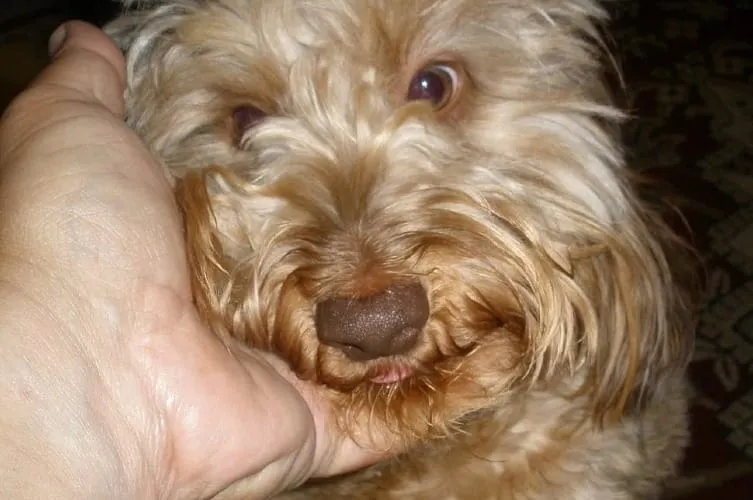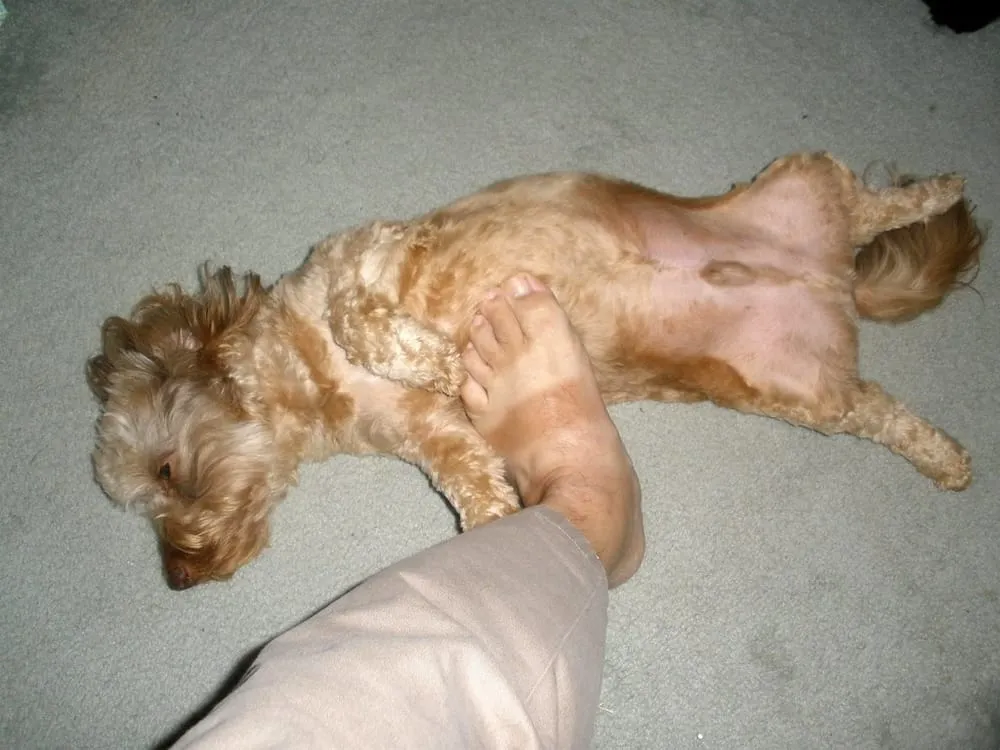If you've ever noticed your furry friend blissfully wagging their tail as you hit that "sweet spot," you know the joy that a good scratch can bring to a pooch. But have you ever wondered what makes certain areas such as the base of their tail, behind the ears, or along their belly so irresistible to your dog's frantic hind leg kicks? Join us as we dive into the world of canine comfort, revealing the science behind your dog's favorite scratching spots and how to safely satisfy their itch.

Whether you're a seasoned dog owner or just curious about canine behavior, this blog post will provide you with insights that will help you and your four-legged best friend live a happier, healthier life together. So, let's explore the spots that send our canine companions into a state of pure bliss!
Understanding the Itch
Itching and scratching in dogs are common behaviors that, when excessive, can signal underlying health issues. The intricate relationship between a dog's nervous system and skin health is central to understanding the causes of itching. Irritants on the skin trigger nerve endings to send itch signals to the brain, prompting the dog to scratch. This scratching, while intended to remove irritants, can further harm the skin and exacerbate the itching, creating a problematic cycle. Research highlighted in the Veterinary Dermatology journal identifies pruritus, or itchy skin, as a leading reason for veterinary visits.
Several factors contribute to itching in dogs, with allergies, parasites, and dry skin being the most prevalent. Allergies, ranging from environmental allergens like pollen to food sensitivities, are a common cause. Parasitic infestations from fleas, ticks, and mites can also lead to significant discomfort and itching. A survey noted that more than half of pet owners face recurring flea infestations. Additionally, dry skin, influenced by environmental factors or nutritional deficiencies, can contribute to itchiness.
To effectively address a dog's itching, identifying the cause is essential. This typically involves a comprehensive vet examination to exclude parasites and infections, followed by allergy testing if needed. Dietary changes may also be recommended in cases of food allergies. Maintaining a detailed record of symptoms and potential allergen exposure can aid in pinpointing specific triggers.

Grooming and veterinary care play crucial roles in managing a dog's itchiness. Regular grooming can help in removing allergens and parasites, potentially reducing the urge to itch. Veterinary intervention is vital for prescribing itch-relieving medications and treating the underlying causes, whether they be allergies, infections, or other conditions. Preventative measures against parasites are also a critical aspect of veterinary care, helping to avoid the itchiness associated with such infestations.
Understanding and addressing the causes of a dog's itchiness is the first step towards providing relief. Through diligent grooming and appropriate veterinary care, many dogs can find significant relief from itch-related discomfort. The subsequent section will explore the specific fascination dogs have with being scratched at the base of their tails, shedding light on why this particular area may provide notable satisfaction.
Key Points:
- Itch Mechanism: Itching is triggered by irritants on the skin, causing dogs to scratch, which can further damage the skin and increase itchiness.
- Common Causes: Allergies, parasites (like fleas, ticks, and mites), and dry skin are primary factors contributing to a dog's itchiness.
- Diagnosis and Treatment: Identifying the cause of itchiness often involves vet examinations, allergy testing, and possibly dietary adjustments. Effective management includes regular grooming and targeted veterinary care, including medication and parasite prevention.
- Preventive Care: Regular grooming and preventive veterinary treatments play essential roles in managing and reducing itchiness in dogs.

The Base of the Tail
Many dog owners have observed their pets fervently scratching or chewing at the base of their tails, an area that seems to be a hotspot for canine irritation. This behavior is not only common but also can signify various underlying health conditions. It's well-documented that the base of the tail is a site where fleas tend to congregate on dogs, leading to intense itching. The prevalence of flea infestations is notable, with over 2,000 flea species known to exist, and the domestic dog flea, Ctenocephalides canis, being one of the most common culprits of pet discomfort.
Signs that a dog enjoys or is desperately seeking relief at being scratched in this area include wagging their tail enthusiastically, leaning into the scratch, or repeatedly nudging the owner's hand for more. However, enjoyment is not the sole reason for this behavior. Sensitivity at the base of the tail can also be attributed to anal gland issues, skin infections, or even psychological stress. While the occasional scratch for pleasure is normal, persistent scratching or biting should be a signal for further investigation by a veterinarian.
Scratching your dog at the base of their tail can provide temporary relief and strengthen the bond between pet and owner. It’s important to monitor the force used during scratching, as the skin in this area can be tender. A gentle approach is always recommended to prevent any harm. Additionally, while scratching your dog, it's an ideal time to check for signs of fleas or other skin abnormalities that may require medical attention.
Approaching the base of the tail with care is not only about providing comfort but also about being observant of a dog's overall health. The next section will delve into the reasons behind a dog's sensitivity in this area and how to provide safe and effective relief. By understanding the appeal and potential issues associated with the base of the tail, owners can ensure they are not exacerbating any underlying problems and are instead contributing to their dog's well-being.

Behind the Ears
Dogs derive immense pleasure from gentle scratches behind their ears, a sensation deeply ingrained in their biology and social behavior. The area behind a dog's ears is packed with nerve endings, and stimulating these through scratching can release endorphins, the body's natural feel-good chemicals, leading to a sense of euphoria or intense happiness. This is evident when dogs lean into the scratch or exhibit a blissful demeanor. Research published in the journal Applied Animal Behaviour Science highlights that physical contact, such as petting or scratching, can significantly lower a dog's heart rate, indicating relaxation and pleasure.
Scratching a dog behind the ears extends beyond a mere physical reaction; it plays a crucial role in the social bond between the dog and its human. This grooming behavior, which dogs cannot easily do for themselves, is integral to canine social structures and helps build trust and affection, thereby strengthening the human-dog relationship.
Observing a dog's body language is key when scratching behind the ears. Signs of enjoyment include relaxation cues like a soft gaze, a slightly open mouth, or a gentle tail wag. However, it's vital to watch for discomfort signals, such as pulling away, ear flattening, or head turning, which might indicate overstimulation or an ear condition needing veterinary care.
The scratching technique is essential for the dog's comfort and enjoyment. Gentle, circular motions with mindful pressure are recommended due to the area's sensitivity. It's also an opportunity for owners to check for any hidden issues like lumps, parasites, or wounds beneath the fur. Paying attention to the dog's reactions and mastering the ear scratch art can provide a soothing experience, reinforcing the bond between the dog and its owner.

- Endorphin Release: Scratching behind the ears stimulates nerve endings, releasing endorphins and inducing euphoria.
- Social Bonding: This act mimics natural grooming behavior, crucial in canine social structures, and strengthens the human-dog bond.
- Observing Body Language: Key to ensuring the dog's comfort, with signs of enjoyment or discomfort informing the interaction.
- Scratching Technique: Gentle, circular motions and pressure awareness are important, along with checking for any skin or ear issues.
The Chest and Neck
Dogs frequently express their desire for physical affection from their human companions, with chest and neck scratches being among their preferred forms of such affection. This preference is deeply rooted in both canine physiology and psychology. The areas around the chest and neck are rich in nerve endings, and when these areas are gently scratched or stroked, it can lead to the release of endorphins in dogs. These endorphins act as natural pain relievers and contribute to a sense of well-being, sometimes even inducing a state of euphoria in the dog.
The soothing effect of chest and neck scratches is often visible in a dog's body language, which may include closed eyes, a relaxed posture, and a tendency to lean into the touch or even paw at their human for more. This type of physical interaction is not only enjoyable for the dog but also serves as an important bonding experience, strengthening the relationship between the dog and its owner. It represents a form of communication that conveys trust and affection from the dog and acknowledges their social needs.
- Endorphin Release: Gentle scratches in these areas stimulate a release of endorphins, enhancing the dog's sense of well-being.
- Bonding Experience: This form of physical interaction strengthens the bond between the dog and its owner, serving as a communication of trust and affection.
When scratching a dog's chest and neck, it's essential to approach the task with care and sensitivity. Dogs can be particularly sensitive to touch in these regions, so starting with soft, slow strokes is advisable, gradually increasing the pressure only if the dog appears comfortable and receptive. It's important to watch for any signs of discomfort or overstimulation, such as the dog pulling away or growling, and to cease immediately if these behaviors are observed.
Safety is another important consideration, especially if the dog wears a collar, like the Fi Smart GPS Tracking Dog collar. Ensuring that the collar doesn't cause irritation or discomfort during the scratching session is crucial. The collar should fit properly, without being too tight or too loose, and should be designed without rough edges or protrusions that could harm the dog's skin.
- Sensitive Approach: Begin with gentle strokes and adjust based on the dog's comfort level, always being mindful of their responses.
- Safety with Collars: Ensure that any collars, such as the Fi Smart GPS Tracking Dog collar, do not cause discomfort during scratching sessions.

The Belly and Sides
For many pet owners, witnessing a dog rolling onto its back with paws up and eyes filled with anticipation is often seen as an invitation for a belly rub. This gesture is more than just a simple plea for attention; it represents a deep level of trust the dog places in its human companion. The belly area, being particularly sensitive due to its thinner skin and higher concentration of nerve endings, makes belly rubs extremely enjoyable for dogs. Research on how domestic dogs react to petting has revealed that gentle touches can lead to calming effects, a reduction in heart rate, and the release of oxytocin, known as the bonding hormone.
Understanding Canine Body Language
Recognizing the signs that a dog wants a belly rub is crucial for interpreting their body language. Indicators such as a relaxed posture, wagging tail, and a gentle, open facial expression suggest that a dog is in the mood for some affectionate belly scratching. However, given the belly's exposed and vulnerable nature, it's essential to approach with caution. A dog's willingness to expose such a sensitive area signifies trust and submissiveness, which must be respected. It's also vital to be mindful of individual sensitivities or medical conditions that might affect how a dog perceives touch.
Benefits of Belly Rubs
Belly rubs offer numerous advantages for a dog's mood and overall health. This form of physical contact not only strengthens the bond between the dog and its owner but also serves as a comforting social grooming activity. It can be particularly reassuring after a stressful event or during bonding moments. Additionally, belly rubs can stimulate the skin and hair follicles, contributing to a healthier coat and skin. These interactions also provide an opportunity for owners to check for any irregularities such as lumps, skin irritations, or parasites.
Proper Belly Rub Techniques
To ensure a pleasurable experience for the dog, it's important to employ the right belly scratching techniques. Gentle, slow strokes are preferable over vigorous rubbing, which may overwhelm some dogs. Observing the dog's reactions and allowing them to guide the hand to their preferred spots can enhance the experience. Preferences vary, with some dogs enjoying light tickles and others preferring a firmer rub. Caution is advised to avoid pressing too hard on the abdomen, especially for dogs with underlying health conditions.
Integrating Technology for Health Monitoring
As we explore further, the role of technology, such as the Fi Dog Collar, becomes evident in monitoring a dog's health and scratching habits. This technology ensures that dogs remain comfortable and healthy by providing insights into their well-being and preferences, marking a significant advancement in the way we care for our furry friends.

Using Technology to Monitor Your Dog's Health and Habits
With advancements in technology, pet owners now have innovative tools at their disposal to monitor and ensure the wellbeing of their furry companions. Wearables like the Fi Smart GPS Tracking Dog Collar are revolutionizing the way we understand our dogs' health and habits. These devices are equipped with sensors that can track a dog's activity levels, including behaviors like scratching, which might indicate underlying health issues. According to a 2021 study published in the Journal of Veterinary Behavior, incorporating technology in monitoring pets' activities can lead to early detection of irregular patterns that may signal the need for veterinary intervention.
The importance of monitoring for excessive scratching cannot be overstated. Excessive scratching in dogs can be symptomatic of various problems, ranging from the common fleas and allergies to more serious conditions like infections or systemic diseases. By using a smart collar with activity monitoring, owners can track the frequency and intensity of their dog's scratching. This data can reveal patterns that might not be obvious during day-to-day interactions, but could be crucial for catching issues before they escalate into more significant health concerns.
Leveraging technology like GPS trackers and activity monitors helps to understand a dog's needs and comfort zones with precision and ease. Pet owners can gain insights into whether their dog is scratching due to boredom, stress, or medical reasons. The data collected by these devices can be invaluable for making informed decisions about a pet's environment, diet, and the need for medical attention, providing a more tailored approach to their care.
Integrating wearable technology data with veterinary advice can create a comprehensive strategy for maintaining canine health. Veterinarians can utilize the information gathered through devices like the Fi Smart GPS Tracking Dog Collar to get a clearer picture of a dog's daily behavior and potentially diagnose conditions sooner. This collaboration between pet technology and professional veterinary care paves the way for a proactive approach to pet health, potentially reducing the risk of complications associated with common issues like skin conditions and allergies. As we look towards the next section, we shall explore the significance of grooming and veterinary care in managing a dog's itchiness and overall skin health.

Conclusion
As we conclude our exploration of "Scratch That Itch: Dog's Favorite Spots Revealed," it's clear that understanding the nuances of our furry friends' scratching preferences can significantly enhance their comfort and our relationship with them. From the base of the tail to the delicate belly, each scratchable spot holds its own charm and health implications. Remember, while a scratch here and there is often appreciated, excessive itching can be a sign of underlying issues that warrant professional attention.
We hope this blog post has provided valuable insights into your dog's scratching behaviors and helped you identify ways to keep your pup content and healthy. Whether you're using technology to monitor their habits, staying vigilant during your petting sessions, or seeking advice from your vet, your efforts contribute to the wellbeing of your beloved canine companion. Thank you for taking the time to read about the simple, yet profound joy of scratching a dog's itch. May your future scratching endeavors be met with many happy tail wags and contented sighs!
FAQs
- Why do dogs enjoy being scratched in certain spots?
- Dogs enjoy being scratched in certain spots like the base of their tail, behind their ears, and along their belly because these areas are rich in nerve endings. Gentle stimulation of these nerves releases endorphins, providing a sense of comfort and pleasure to the dog.
- What does excessive scratching in dogs indicate?
- Excessive scratching in dogs can indicate underlying health issues such as allergies, parasites (like fleas or ticks), skin infections, or dry skin. It's a sign that the dog is trying to alleviate discomfort or irritation.
- How can I safely scratch my dog's itch?
- Safely scratching your dog's itch involves using gentle strokes and being mindful of their reactions. Avoid scratching too hard, particularly in sensitive areas like the base of the tail, behind the ears, and the belly. Watch for signs of discomfort or overstimulation, and always stop if the dog seems uneasy.
- Can excessive scratching be managed with grooming and veterinary care?
- Yes, regular grooming can help manage a dog's itchiness by removing allergens and parasites from their coat. Veterinary care is crucial for diagnosing the cause of the itchiness and prescribing appropriate treatments, which may include medications, dietary adjustments, or allergy testing.
- What role do fleas play in a dog's scratching behavior?
- Fleas are a common cause of scratching in dogs. They can cause severe discomfort and lead to flea allergy dermatitis. The base of the tail is a common area where fleas congregate, causing dogs to scratch or chew at the site to relieve the itch.
- How can technology like the Fi Smart GPS Tracking Dog Collar help monitor a dog's health and scratching habits?
- Devices like the Fi Smart GPS Tracking Dog Collar can track a dog's activity levels, including scratching behaviors. This data can help pet owners detect excessive scratching early on, which might indicate health issues that require veterinary attention.
- What should I do if my dog's scratching becomes excessive?
- If your dog's scratching becomes excessive, it's important to consult a veterinarian. They can help identify the cause of the itchiness and recommend appropriate treatments, which might include medications, changes in diet, or specific grooming practices.




